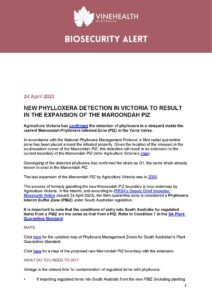Agriculture Victoria has confirmed the detection of phylloxera in a vineyard inside the current Maroondah Phylloxera Infested Zone (PIZ) in the Yarra Valley.
In accordance with the National Phylloxera Management Protocol, a 5km radial quarantine zone has been placed around the infested property. Given the location of the vineyard in the southeastern corner of the Maroondah PIZ, this detection will result in an extension to the current boundary of the Maroondah PIZ (refer Agriculture Victoria’s map).
Genotyping of the detected phylloxera has confirmed the strain as G1; the same strain already known to exist in the Maroondah PIZ.
The last expansion of the Maroondah PIZ by Agriculture Victoria was in 2020.
The process of formally gazetting the new Maroondah PIZ boundary is now underway by Agriculture Victoria. In the interim, and according to PIRSA’s Deputy Chief Inspector Biosecurity Notice (issued 24 April 2023), the 5km quarantine zone is considered a Phylloxera Interim Buffer Zone (PIBZ) under South Australian legislation.
It is important to note that the conditions of entry into South Australia for regulated items from a PIBZ are the same as that from a PIZ. Refer to Condition 7 in the SA Plant Quarantine Standard.
Maps
- Click here for the updated map of Phylloxera Management Zones for South Australian’s Plant Quarantine Standard.
- Click here for a map of the proposed new Maroondah PIZ boundary with the extension.
What do you need to do?
Vintage is the riskiest time for contamination of regulated items with phylloxera.
- If importing regulated items into South Australia from the new PIBZ (including planting material, machinery and equipment, wine grapes, table grapes, must, unfiltered juice, filtered juice, marc, diagnostic samples and vineyard soils), you mustcomply with –
- Movement conditions outlined on Agriculture Victoria’s website to leave a PIZ and the proposed extension (the extension referred to as a PIBZ in SA); AND
- Entry conditions applicable to a PIBZ in the South Australian Plant Quarantine Standard Condition 7
- Extreme caution is also required in relation to people movement, given that footwear and clothing can pick up and spread phylloxera. Accordingly, Vinehealth Australia urges all vineyard owners to review their interstate links and ensure safe movement of people onto and within their vineyards. Refer Vinehealth Australia’s ‘Biosecurity Planning for Hosting Visitors’ fact sheet for best practice information.
Vinehealth urges industry to be especially vigilant with any planned movements of regulated items out of a PIBZ, PIZ or PRZ into SA. Current penalties for non-compliance with conditions of entry for regulated pests apply under the South Australian Plant Heath Act 2009 and are up to $100,000 for companies and $20,000 for individuals.
What next?
In consultation with PIRSA, Vinehealth Australia will provide timely updates to industry on this recent detection as we receive additional information that can be shared.
We continue to advocate to state regulators and industry for the review and update of the National Phylloxera Management Protocol to be urgently completed. This document has not been reviewed since it was first published in 2009, despite the availability of new science on phylloxera survival (incorporating strain information) and detection methods, contemporary biosecurity thinking and the spread of phylloxera in Victoria.
This new phylloxera detection is a reminder to all South Australian grape and wine businesses that phylloxera remains an ever-present risk.
Enquiries
Please contact PIRSA Biosecurity SA on 08 8207 7814 or PIRSA.PlantHealthMarketAccess@sa.gov.au.
